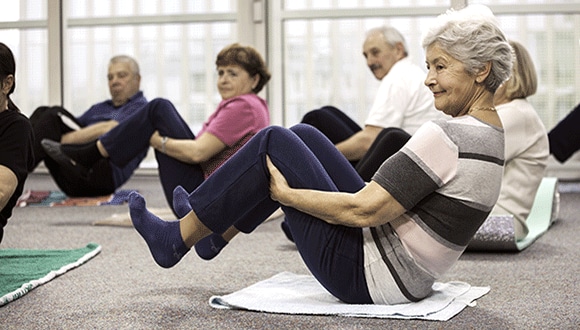Why core strength is important
A strong core can help to reduce the risk of lower back pain, improve your balance and help you with day to day physical activities. Here are simple ways to help you strengthen your core, every day.
Charmaine Yabsley
May 2018
You may have heard people talk about “core strength”, or that it’s important to “tighten your core”. But what does it mean, and why does it matter?
Your core isn’t just your 6-pack, but a combination of muscles that are vital for your body’s overall strength and stability.
“It refers to all the muscles that support and stabilise your midsection, starting from the deep pelvic floor muscles all the way up to your neck. When we move our body, the back muscles, abdominals, glutes and a whole bunch of tiny muscles and fascia [connective tissue] should work together to create something called intra-abdominal pressure. This pressure turns our midsection into a firm, strong unit,” says exercise physiologist Amelia Phillips.

Why it’s important to strengthen your core
A strong core can improve your balance and stability, prevent injuries and can make it easier to do a range of physical activities – from training in the gym to tying your shoe laces. A strong core isn’t just for professional athletes.
Around 1 in 6 Australians are affected by back pain and Phillips says that many problems associated with back pain can be alleviated by strengthening your core and reducing sitting time.
“If our core is weak, we’re no longer protecting our spine, hips and other joints effectively. A weak core also means our posture deteriorates so that the natural curve in our spine becomes over-pronounced, placing more pressure on the spine.”
This vicious cycle can result in compression of the important intervertebral discs and an increased risk of injuries such as slipped discs.
Sitting is another cause of back pain. On average, Australians sit for around 10 hours a day. But we can counteract the damage of sitting by training our core.
What are the best ways to strengthen your core?
Your pelvic floor muscles span the bottom of your pelvis and engaging them will help strengthen your core. There are different ways for men and women to exercise these muscles. Continence Australia provides a general exercise to locate and exercise these muscles
Squeeze and draw in the muscles around your back passage and the vagina or base of the penis. You should have a sense of “lift” each time you squeeze your pelvic floor muscles. Try to hold them strong and tight as you count to 8. Then let them go and relax. You should have a distinct feeling of “letting go”.
Once you’ve mastered that, you can train your core with functional moves that mimic everyday life, such as squats and deadlifts [raising a weight off the ground to hip level].
“Moves where you keep your back straight and neutral while lifting something heavy will help train your core to protect your back,” says Phillips.
But make sure you don’t overdo the weights – it’s better to start small and only lift what your body can comfortably manage.
If you’re not sure you’re engaging your core correctly, try a Pilates class, where you will learn how to correctly engage your core.
How can you strengthen your core throughout the day?
“The great thing about the core is that it responds quickly even to small amounts of training,” says Phillips. “Little bursts of core training throughout the day really do make a difference.”
She recommends doing the following movements throughout the day.
Diaphragmatic breathing: Take a deep breath in and then as you breathe out, draw your belly button in towards your spine. When you breathe in, relax and allow your belly to expand. Most people breathe the other way round or shallow breathe. Practise this every day until it feels natural.
Belly button in when you lift: Every time you pick something up, draw in your belly button. This goes a long way to protecting your spine.
Balance on one leg: You might feel silly, but your core will thank you. The instability of standing on one leg forces your core to work overtime to prevent you from falling. The more you practise single legwork, the more responsive your core becomes. You can even do this while brushing your teeth, drying your hair or waiting for the kettle to boil.
Plank during the TV ads: When watching TV, get down on the floor for a core strength session. With your forearms on the ground, start on your knees. Once you can hold a plank for 45 seconds in this position, do 20 seconds on your toes, and repeat 6 times. Someone with a strong core can hold a plank for 2 minutes with no rest. See tips on perfecting your plank.
Women can find online help on strengthening their core, including after pregnancy, at The Pelvic Expert.
Related articles
THE IMPORTANCE OF FITNESS IN YOUR 40S
If you’re in (or edging close to) your 40s take note; building exercise into your life can boost your health, now and in the future.
WHY MIXING UP EXERCISE IS GOOD FOR YOU
Trying a new workout could help you stick to your fitness goals.
BEATING LOWER BACK PAIN
Your lower back does all the heavy lifting for your body so it’s important to look after your lumbar spine.
IS YOGA IS GOOD FOR YOU?
More people every year are turning to yoga, but are there proven health benefits?